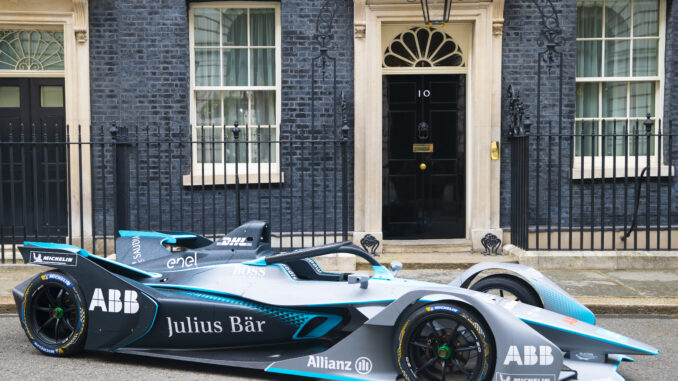
Formula E is similar to Formula 1 (F1) in many ways; elite racing drivers, wheel-to-wheel battles, world championships and cars on the cutting edge of automotive engineering. Yet there’s just one major difference: Formula E is all electric. That’s what the “E” in its name stands for, after all.
What makes Formula E so unique? There are a plethora of reasons.
For starters, the cars themselves. The electric racing cars look like brutalist abstract art on wheels and sound like demonic dental drills. The sound has also been likened to “spaceships,” “vacuum cleaners” and even “RC cars on steroids.” Believe it or not, many motorsport fans are turned away by Formula E just for the sound alone, which many find annoying and unexciting.
All Formula E cars share the same chassis, battery, aerodynamic pieces and tires, which is done to save development costs. However, each team has the freedom to tinker with their powertrain, which includes the gearbox and energy recovery unit.
There are 12 teams with two drivers each, which means there are 24 cars for every “e-prix.” Race weekends consist of practice sessions, qualifying and the race itself, just like F1 – but there’s a catch.
The “quali” sessions are split into four groups based on each driver’s rank in the standings. Each driver has six minutes to set their fastest time. The top six from that session have one more chance at a fastest lap, with the best driver securing “pole position,” or starting the race in first. Each “e-prix” lasts 45 minutes. Once the 45 minutes is up, every driver must race for one more lap before the checkered flag is waved. In F1, race length is dictated by the length of the track with a two hour time cap.
Mercedes driver Nyck de Vries is the current leader in the driver’s standings with 32 points and Jaguar is the leading constructor, with 40 points.
Another difference between the two motorsports is the type of tracks they run on. F1 races are run on both purpose-built race tracks and long street circuits. In Formula E, all races are on short, narrow street circuits constructed in the middle of cities such as Berlin, Rome and even Brooklyn. This is done not just to conserve battery life but also to make racing more exciting. Most of the time, cars are literally inches from colliding and makes me scrunch my face in suspense.
Formula E has come a long way in terms of technology since its first season in 2014-15. For example, up until 2018, the cars had limited battery life that couldn’t last an entire race, which meant that drivers had to change cars in the middle of the race.
It sounds crazy but it’s true; during a pit stop, the driver had to quickly hoist himself out of his current car, run to the new one and be strapped in by mechanics before whistling away to rejoin the race.
The first generation of cars, lasting from 2014 to 2018, only had 201 horsepower during races. A nicely equipped Honda Accord has more power than those initial cars. The current cars have 270 horsepower at the drivers’ disposal during races, a number that definitely appears more reasonable for a race car.
Formula E has a few tricks up its sleeve to draw in motorsport fans to a polarizing series. One of these is ATTACK MODE (yes, in all caps). Drivers can risk their position in the race by venturing away from the pack and driving over a designated part of the track which gives their cars an extra 35 kilowatts of power for a few laps and the chance of finishing higher. They can only use this once per race, so it all comes down to perfect strategy and timing to maximize its benefits.
Another feature, albeit controversial, is FANBOOST (they love all caps). Fans vote on their five favorite drivers from six days prior to the race up until 15 minutes into the race. These top five drivers get a 15-second boost of power they can use whenever they want during the race to gain an advantage. You literally get the ability to affect the outcome of a race while it happens.
Could this backfire where fans join up and promote the same drivers each week to make sure they win every time? In theory, yes, but it’s so insignificant and rarely substantially affects the outcome of a race. It’s gimmicky, yes, but it also gets people to talk about the sport.
I get that F1 has all the money, glamour, fans and legacy. That’s why it’s so popular. That’s why I write about it all the time. But don’t neglect Formula E. If you can’t stand the drama surrounding F1 and the copious amount of carbon emissions caused by traveling but love the concept of sustainability or simply new electric car tech, then give Formula E a shot. The future of automobiles is going electric, after all.

